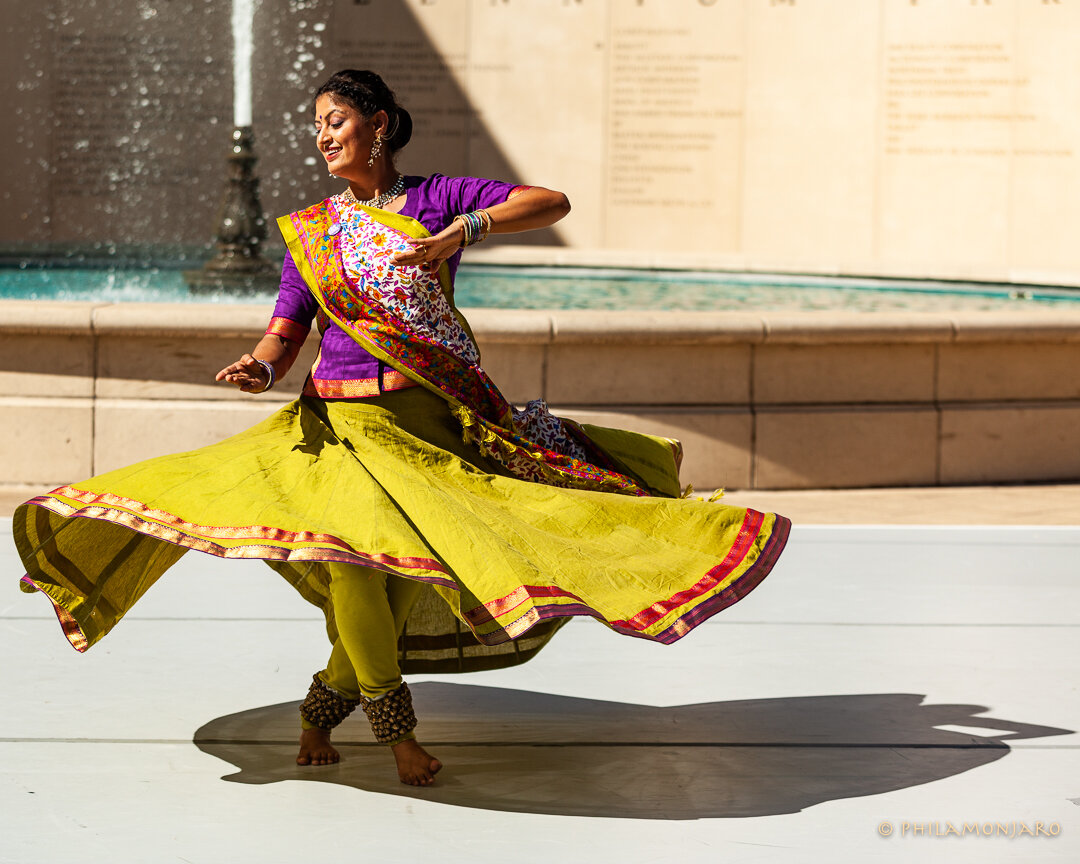KATHAK: an Indian Classical Dance form, is the culmination of years of varied cultural influences on the art that emanated from the story-tellers of the ancient temples. The name Kathak is derived from the Sanskrit word ‘kathā’ meaning story.
Kathak contains traces of temple and ritual dances, along with certain features of Persian and Central Asian dances. Intricate footwork and spins, as well as abhinaya, the art of expression, are the highlights of Kathak.
“The most striking thing about Kathak in comparison with the other dance styles is the impression it creates of extreme subtlety.”
Namaskār: is done before starting and at the end of a dance practice and presentation showing respect to God, Guru, Musicians, Stage, and the Audience. This is a symbolic way of seeking their blessings and permission.
Ghungru: Metal bells tied on a cotton cord, worn around the ankles by the dancer. These are the primary instrument of a Kathak dancer and should be respected and taken care of by the dancer
Warm-Up: Before starting a dance practice and presentation a dancer must warm-up. Warm-up may comprise of simple exercises that get the body and mind ready for movement. The main purpose of warm-up is to increase the heart-rate and get the blood flowing.
After gradual pulse raisers like walking then jogging, some joint mobilizers and dynamic stretches (short hold) are recommended. For example point and flex feet and rotate ankles; press heels and bend & stretch knees; rotate hips and stretch waist (sides, forward and back, twist example with triangle pose). Rotate wrist, shoulders, arms and roll neck. Stretch, curl and uncurl fingers and move head up & down, side to side etc.
Kathak movements like Suchita and Angles Exercises assist in hand-eye coordination. Posture is extremely important to ensure safety. Focus on alignment (ankle-knee-hip and wrist-elbow-shoulder)
Cool-Down: At the end of a dance practice and presentation the dancer must cool down. Cool-down may comprise of simple stretching exercises that gets the body and mind to slow down. The main purpose is to gradually slow down and get the heart-rate and breathing back to normal. It is important to stretch the muscles, preventing one from getting injured or sore. Yoga poses like Vajrasana, child’s pose etc are highly recommended. For example - Uttanasana is an excellent stretch pose (standing forward fold) that also calms the mind.
Teentāl: is a 16 Mātrā (beat) timecycle divided into 4 Vibhāgs (divisions/ sections) of 4 beats each, 4 + 4 + 4 + 4. It has 3 Tālis, at beats numbered 1, 5 and 13. It has 1 Khāli, at beat number 9. Thekā or the tablā bol for teentāl is dhā dhin dhin dhā dhā dhin dhin dhā dhā tin tin tā tā dhin dhin dhā
GLOSSARY
Tāl: Rhythmic time-cycle that repeats again and again.
Mātrā: Beat, Unit of measuring duration of a Tāl
Vibhāg: Division or section of a Tāl
Tāli: literally: ‘clap’. Used to show the accented beat in a Tāl.
Khāli: literally: ‘empty’. A blank beat, negative accent in a Tāl.
Tablā: A percussion instrument often used as an accompaniment to Kathak dance. It is comprised of two drums.
Bol: A Bol is a sound or syllable. Helps identify and recite rhythms.
Thekā: Thekā is the Tablā bol for a Tāl that repeats again and again
Ᾱvartan: One cycle of a Tāl
Sam: The first beat of a Tāl
Tatkār: Dance syllables produced from stomping. Basic footwork for a Tāl.
Kavitt: A composition based on a poem (Kavitā). It has bols that have meaning.
Lari: A chain of footwork patterns, ends with a tihāi
Laya: Laya means tempo. Duration between beats determines Laya of a Tāl or a Tāl based composition.
Parhant: Recitation of bols of a composition indicating beats of a Tāl.
Torā: A group of bols or syllables that starts and ends on sam.
Tihāi: A rhythmic pattern that repeats three times.
Chakkar/ Pheri: literally: spin. The Chakkar in Kathak is performed on the heel.
Asamyukta Hasta: Single Hand Gestures (Ref book - Abhinaya Darpana by Nandikeshwara) for example
(1) Pataka - Flag - Palm open, fingers together
(2) Hamsasya/ Hansasya - Swan Beak - Index finger and thumb tips touch. other fingers open
(3) ArdhaChandra - Half Moon - Fingers together, thumb is separated , open
(4) Mushthi - Fist
(5) Suchi - Needle (number 1, index finger open from mushthi)
(6) Mayura - Peacock - Ring finger and thumb tip touch
2019 Chicago Summer Dance
KATHAK QUIZ - MAY 2024
MATCH THE FOLLOWING
(1) Barābar Laya (a) Asamyukta Hasta
(2) Odissi (b) Right hand opens to the front and is pulled back while the left arm moves upward executing Urdhva Hasta Chakra before coming down with completion of the body spin.
(3) Sarpashirsha (c) Typical Bols: ta ka ta ki Ta
(4) Ᾱlingan (d) Stage Salutation
(5) Pavanpheri (e) A musical composition using syllables like ‘deem’, ‘ta nome’, ‘dere na’
(6) Tarānā (f) Use of gestures and actions implemented using the physical body
(7) Khanda Jāti (g) Nritta Hasta. Literally means ‘embrace’
(8) Damdār Tihāi (h) When there is space between the three repetitions
(9) Salāmi (i) An Indian Classical Dance form
(10) Ᾱngika Abhinaya (j) Speed of one Bol per beat
MONTHLY QUIZ ANSWERS
QUIZ ARCHIVES
Reference Books and Recommended Reading
ANG KAVYA by Pt. Birju Mahārāj
ABHINAYA DARPAN by Nandikeshvara
NATYA SHASTRA by Bharat Muni
KATHAK DANCE SYLLABI by Dr Puru Dhadheech
KATHAK: The Dance of Storytellers by Rachna Ramya
BIRJU MAHARAJ: The Master Through My Eyes by Saswati Sen
MOVEMENT IN STILLS: The Dance and Life of Kumudini Lakhia by Reena Shah


